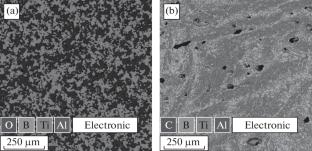Abstract—Metal additive manufacturing is widely studied for its unique advantages over traditional manufacturing processes. It is used to form complex components of Ti, Fe, or Ni alloys. However, for nonferrous alloys—aluminum, magnesium, copper—additive technologies are not used because of rapid melting during laser, electron beam, and/or arc treatment. Cold spraying is widely used as an effective technology for applying high quality coatings in the mass production of metal and alloy products and/or metal matrix composite coatings. In addition, cold spraying is a serious and effective tool for the additive manufacturing of metals, and research in this area is currently becoming intense. It is shown in the work that the use of cold spraying technology makes it possible to obtain composite materials based on aluminum and titanium reinforced with boron carbide. Zirconium dioxide chosen as the reinforcing component could not be introduced into the composite based on aluminum and nickel, which is most likely due to the large particle size. During thermal treatment of materials obtained by cold spraying, new chemical compounds are formed—both intermetallic compounds and hardening ceramic inclusions that increase the microhardness. At the same time, the microhardness increases by about 7 times, but the linear dimensions decrease, which is not observed in the system based on nickel aluminide. However, as a result of a change in the structure during chemical transformations, a change in the geometry of the product and the formation of pores can be observed.



